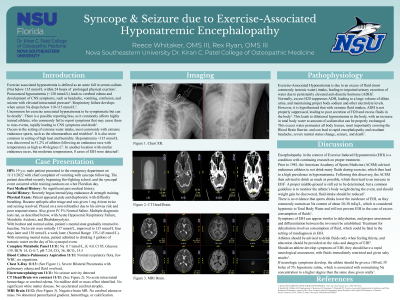Back

Clinical: General Topics
Syncope and Seizure in Fire Trainee due to Exercise-Associated Hyponatremic Encephalopathy
Friday, March 31, 2023
12:00 PM East Coast USA Time


Reece Whitaker, n/a
OMS-III
Nova Southeastern University Dr. Kiran C. Patel College of Osteopathic Medicine
Ocala, Florida, United States
Presenting Author(s)
Introduction: A 19-year-old male, with no significant past medical history, presented to ED following a syncopal episode and associated vomiting. On physical exam, he appeared pale and diaphoretic with difficulty breathing. After triage, he began seizing and was intubated due to risk of aspiration. Labs revealed Na 117, pH 7.24, CO2 36, HCO 15.5, K 4.0, Cl 85, and Glucose 139. Chest X-Ray revealed severe bilateral pneumonia with pulmonary edema. CT Head/Brain revealed no acute intracranial hemorrhage, cerebral edema, midline shift, mass effect, hydrocephalus, or significant white matter disease. With administration of intermittent 3% IV normal saline, serum sodium improved to 135 mmol/L after four days, followed by 138 mmol/L after seven days. Upon further questioning, he endorsed drinking three gallons of water on the morning of the syncope while training as a firefighter on a hot day.
Case Study: Exercise-associated hyponatremia (EAH) is an acute fall in serum sodium below 135 mmol/L, within 24 hours of prolonged exertion. Hyponatremia below 120 mmol/L may present as headache, vomiting, confusion, and seizure with elevated intracranial pressure and cerebral edema. Respiratory failure with pulmonary edema may result with Na below 115 mmol/L.
EAH is most common with heavy exertion and prolonged endurance, especially concurrent with high heat and humidity. The most commonly affected are experienced athletes who believe they only over-exerted themselves. As such, there is high reporting bias, as most believe there is no reason to seek treatment.
Discussion: The best treatment for EAH is prevention, especially while participating in an event requiring extreme physical exertion in a hot, humid climate. Prior to 1981, athletes were advised to drink as little as possible during exercise. After a spike in hypernatremia incidents, the ACSM endorsed excess fluid intake during exercise, leading to increased incidence of EAH. There is no evidence supporting that sports drinks lowers the incidence, as the sodium content is hypotonic at 20-30 mEq/L. It is hypothesized that monitoring weight during exercise may help prevent EAH, as weight gain may indicate hypotonicity and fluids should be reduced. Treatment of a stable EAH patient includes monitoring neurologic status, limiting fluid intake, and observation. Declining neurologic function should be treated with IV rehydration rather than oral. Rogers, et. al. (2013) determined that a 100 mL bolus of IV 3% hypertonic saline is associated with normalizing Na concentration better than oral administration. Additional research on the topic is imperative in preventing additional EAH cases.
Case Study: Exercise-associated hyponatremia (EAH) is an acute fall in serum sodium below 135 mmol/L, within 24 hours of prolonged exertion. Hyponatremia below 120 mmol/L may present as headache, vomiting, confusion, and seizure with elevated intracranial pressure and cerebral edema. Respiratory failure with pulmonary edema may result with Na below 115 mmol/L.
EAH is most common with heavy exertion and prolonged endurance, especially concurrent with high heat and humidity. The most commonly affected are experienced athletes who believe they only over-exerted themselves. As such, there is high reporting bias, as most believe there is no reason to seek treatment.
Discussion: The best treatment for EAH is prevention, especially while participating in an event requiring extreme physical exertion in a hot, humid climate. Prior to 1981, athletes were advised to drink as little as possible during exercise. After a spike in hypernatremia incidents, the ACSM endorsed excess fluid intake during exercise, leading to increased incidence of EAH. There is no evidence supporting that sports drinks lowers the incidence, as the sodium content is hypotonic at 20-30 mEq/L. It is hypothesized that monitoring weight during exercise may help prevent EAH, as weight gain may indicate hypotonicity and fluids should be reduced. Treatment of a stable EAH patient includes monitoring neurologic status, limiting fluid intake, and observation. Declining neurologic function should be treated with IV rehydration rather than oral. Rogers, et. al. (2013) determined that a 100 mL bolus of IV 3% hypertonic saline is associated with normalizing Na concentration better than oral administration. Additional research on the topic is imperative in preventing additional EAH cases.
